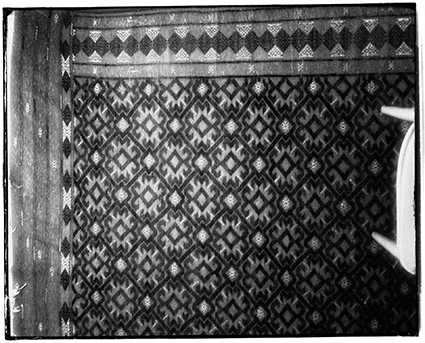Years ago I bumped into an aquaintance who wanted to know what I was working on. I told her it was a series about Potiphars wife. “Oh, that bitch!!!” was her reaction. I nearly burst into tears. “She is not a bitch!” I always get terribly attached to the characters I photograph. And they are never bitches.
It’s a nasty story, that of Zuleika. For that was her name. She was married (arranged, of course) to Potiphar, a fat old flabby – I imagine – top dog in Pharao’s court. When Joseph appeared there, she fell hopelessly in love with him. The boy was such a conceited, spoiled little brat that his brothers had thrown him into a well. They meant to teach him a lesson – they even considered killing him. In the end they sold him to a passing caravan, which is how he had ended up at the Egyptian court. Officially as a slave, but it wasn’t long before he landed a job as confidant of the pharao. A whole year long he paid daily visits to Zuleika, flirting like crazy probably, but never touching her. One unlucky day it became too much for her, and – according to the horribly moralistic tale – she threw herself at him. He fled the room and forgot his cloak (you know, Technicolor Dreamcoat and all that). In her despair, Zuleika accused him of sexual assault, and he was thrown into jail. Only to be released again in no time – after which he was appointed court dreamologist and eventually making it to viceroy. Poor Zuleika was completely stuck.
Potiphars wife has long been a highly desirable subject for artists. Undoubtedly because it gave them an excuse to paint a hot (naked) broad, in the meantime hiding behind morality. After all, no one spoke about female sexuality – that was something to be savored in secret and denied in public. It was solely for ‘bitches’.
I know a Hebrew scholar who, as a student, was instructed to skip the story of Zuleika (Genesis 39). Good thinking, university! That way you make certain that each and every student reads it.

Master of Affligem, ca 1500. A painter we basically know nothing about, except that he came from Flanders and that he painted six tondi, round paintings, about the life of Joseph – which is why he is also known as ‘Master of Joseph’. Here he tells the the entire episode with Zuleika in one image: she grabs him (with an extremely motherly look in her eyes), on the right she points at ‘exhibit A’, and behind that we see Joseph being captured.

Pieter Coecke van Aelst, 1540. It looks like William Blake! But it was made three hundred years earlier. Mrs. P . has a really modern hairdo – actually they both have very modern looks. It is an incredibly dynamic painting. Here too, the course of the story is depicted in the background.

Anonymous artist, slightly later than Coecke van Aelst, and painted in a slightly clumsier manner. But it’s hilarious to see how the entire household goes into disarray. And those jugs in front of the bed, all the time? Yup, you got it. Sexual symbols.

An engraving by Harmen Jansz Muller, after Maarten van Heemskerk, ca 1600. Man, is she ugly, this particular mrs Potifar. And the place is swamped with creepy monsters. In this case, I’m with Joseph.

Ludovico Cigoli, 1610. Italian Baroque painters could not get enough of our story. They have all made multiple images of it, over and over again. With models who all had the same, slightly slimy expression on their faces. I’ve chosen Cigoli on account of those crazy shoes.

The lustiest Zuleika is by Rembrandt (1634). And his Joseph is visibly in two minds. In other words, they are by far the most human. This etching truly is another shining example of Rembrandt’s genius.

Costume design by Léon Bakst for the ballet La Légende de Joseph. Staged in 1914 by Les Ballets Russes, Sergei Diaghilev’s company, with music by Richard Strauss. Speaking of crazy shoes! These are cothurni, originating from the ancient Greek theater, later often worn by Venetian hookers, but hardly ever used in ballet performances. Dancing in them sucks.

India, 1888. In the Qoran, Zuleika is mentioned by name, and the story is told more extensively there. It describes how she introduces Joseph to her girlfriends. The women, who are peeling oranges, are so dazzled by his beauty, that they collectively cut their fingers. Apparently the scene turned quite bloody. I really appreciate that their feelings were taken into consideration!

And finally, my own Zuleika, portrayed by stunning Dutch actress Anna Drijver (2005). Persistent rumors have it that Potiphar was a eunuch. What a crappy life that girl must have had – and then going down in thousands of years of history as a bitch, too . . .
Brave, beautiful Zuleika, I think you are fantastic!
